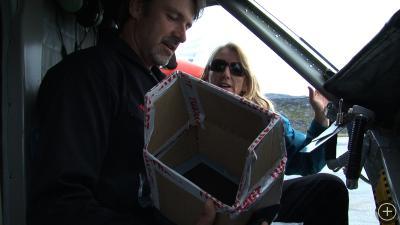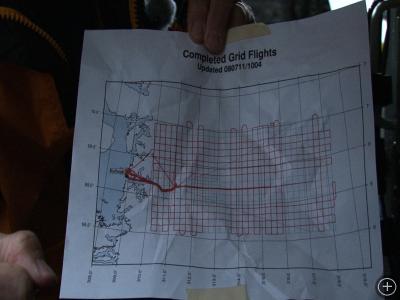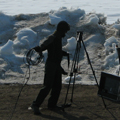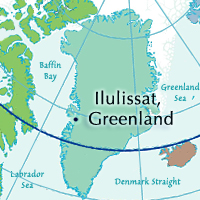Transportation in Support of Science: The Twin Otter
ILULISSAT, GREENLAND– (By Lisa Strong-Aufhauser) An aircraft we never did get to fly in while it was on its science mission was a de Havilland Canada DHC-6 Twin Otter. A joint University of Kansas/NASA project employed the Twin Otter to carry their ground penetrating radar and precise GPS readers over the Jakobshavn Glacier (and beyond) to map both the ground beneath and the ice surface above. The Twin Otter crew was charged with flying the grid lines very precisely, without banking. Necessity being the mother of invention, the flight crew and scientists worked together to rig a monitor that the pilot or co-pilot could use to follow the grid lines while still flying the plane.

Pilot Andrew Wojcicki with the monitor he or the copilot uses to follow the grid lines while flying.
We saw one of the grid maps. The flight crew must have been spinning aerial half brodies at the end of each line to stay flat and achieve their results.
Mary was pretty excited, specifically, about the Kenn Borek Twin Otter as they also serve the US Antarctic Program. She saw a number of the distinctively painted planes during her 2001 Antarctic trip. Find out why the Twin Otter is such a good platform for research as Mary talks to the pilot, Andrew Wojcicki.
Get the Flash Player to see this player.












Another interesting bit of info. Never realized that there were planes especially made for the bush. Who makes them?
Hi Mom –
de Havilland Canada started making them in 1966. They’ve been out of production for almost 20 years, I think. But recently Viking Air, a company out of British Columbia, who has been making spare parts for the originals – got rights to start making new ones. The new Twin Otter Series 400 is supposed to start shipping in 2009.
Here’s a fun video on the history of de Havilland bush planes: http://www.vikingair.com/video/viking.wmv
And here’s even more info on the Twin Otter: http://en.wikipedia.org/wiki/De_Havilland_Canada_DHC-6_Twin_Otter
Lisa